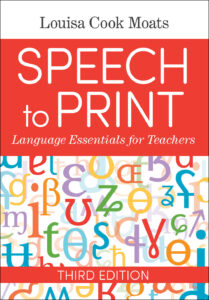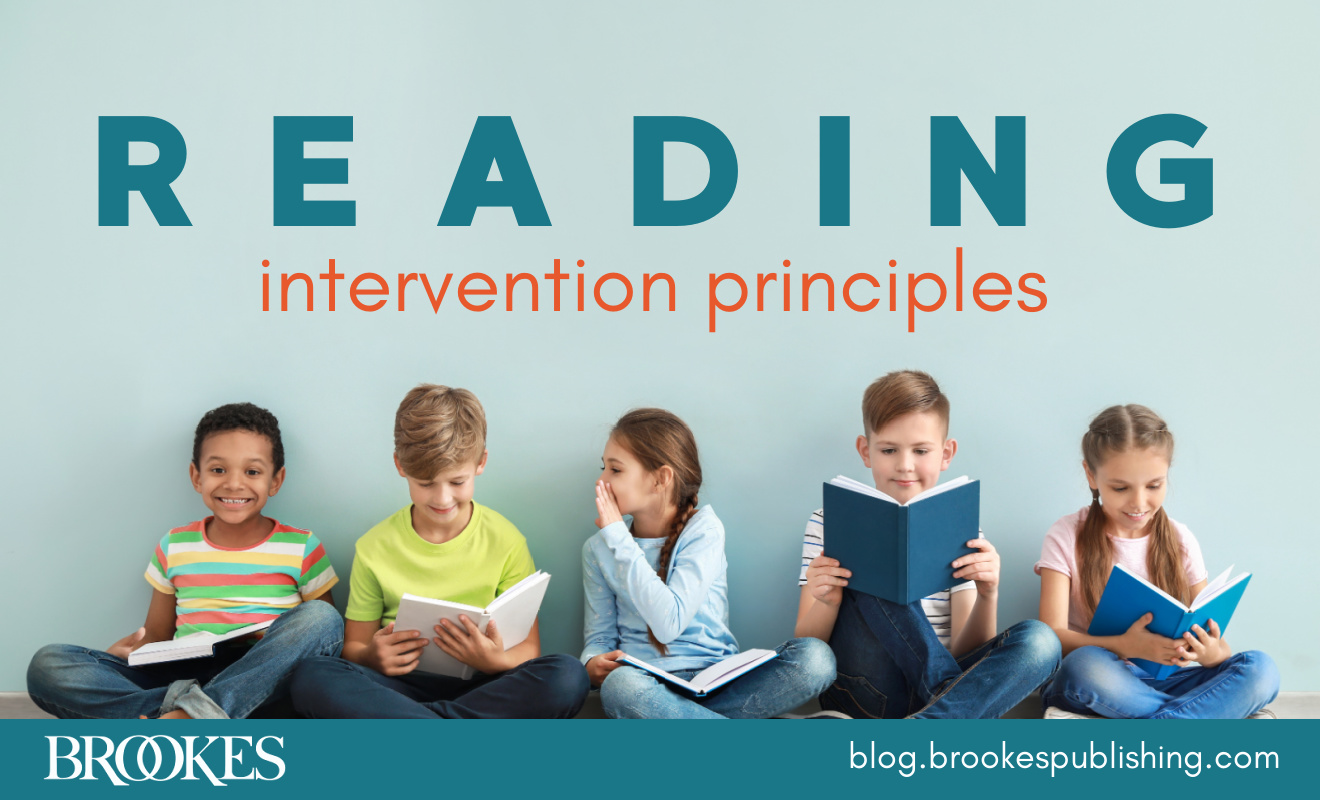10 Big Ideas for Refining Your Literacy Instruction
June 2, 2023
 Once you’ve mastered the key principles of evidence-based literacy instruction, how can you fine-tune your teaching and make it the best it can be? Today’s post offers 10 ideas for refining your instruction, excerpted and lightly adapted from the third edition of Speech to Print by Louisa Cook Moats, Ed.D.
Once you’ve mastered the key principles of evidence-based literacy instruction, how can you fine-tune your teaching and make it the best it can be? Today’s post offers 10 ideas for refining your instruction, excerpted and lightly adapted from the third edition of Speech to Print by Louisa Cook Moats, Ed.D.
***
High-quality instruction in language and literacy is necessarily complex. While the components of an explicit lesson are fairly standard across many well-designed programs, a knowledgeable teacher can enhance the power of those frameworks with keen observations of student behavior and a clear sense of where to aim the instruction. Keep these 10 big ideas in mind:
Awareness of speech is the foundation for learning print.
- Written symbols were invented to represent spoken language, not the other way around. The anchor for learning print is awareness of speech.
- Letters do not “make” sounds, they represent them.
- While print can make visible what is in a spoken word, print can also be misleading. For example, there is no /l/ in
- Written syllable chunks and spoken syllable boundaries are different.
- Morphemes may be more apparent in print than in speech; pairing speech with print is especially helpful with study of morphology.
Speech sounds are obscured by coarticulation and students need explicit teaching to become aware of them.
A mindful teacher is likely to:
- Identify, isolate, and pronounce a phoneme before teaching how it is spelled.
- Speak slowly and clearly and ask for eye contact.
- Use a set of mouth form pictures to supplement sound–spelling cards or refer to articulation during instruction.
- Ask students to repeat and pronounce sounds and words clearly during instruction.
- Recognize when “listening harder” or “saying a word slowly” will not be helpful, for example while spelling multisyllable words with several schwa vowels.
Examples for linguistic concepts must be carefully chosen.
For example, to avoid common errors in phonics instruction:
- Use consonant and vowel sound–symbol cards with relatively undistorted key words (toy, not train; edge, not egg, etc.).
- Instead of teaching that each letter has a sound, teach that phonemes are presented by graphemes and practice phoneme–grapheme mapping
- Keep the speech–print difference in mind, remembering for example that the consonant-vowel-consonant (CVC) pattern refers to speech sounds, not letters, and CVC word lists do not include -ow, -oy, or vowel + r combinations
Substitute “sound walls” for “word walls.”
Instead of using a classroom wall to post a list of high-frequency words under each letter of the alphabet, as is often done in elementary classrooms, create “sound walls” for consonants and vowels. A single, high-frequency grapheme is introduced for each phoneme; gradually, other common graphemes are added as they are learned.
Follow a scope and sequence or roadmap to cover all relevant content.
Although there is no one single or optimal scope and sequence for teaching phonology, phonics, morphology, or syntax, some sequences are better than others, and some have serious flaws.
- Teach wide contrasts before close contrasts, for both sounds and symbols. For example, don’t teach “m” and “n” together, or “i” and “e,” or “g” and “j.”
- Spend more time and provide more practice with letter names and sounds that are confusable.
- Teach a few consonants with a vowel that can be blended into words. Continue introducing consonants and vowels in sets that increase word-building opportunities.
- Teach the most common correspondences and patterns before less common ones.
Make sense of spellings and demystify spelling patterns.
National spelling bee contestants are allowed to ask about a word’s pronunciation, meaning, and etymology before they spell the word. Information about phoneme–grapheme links, orthographic patterns and constraints, language of origin of a word, morphology, and grammar and syntax may all be drawn upon at times as we explain why words are spelled the way they are. Again, we are more likely to remember something that makes sense. Gaining insight into how words work is also fun and intrinsically rewarding.
Minimize rote instruction of sight words.
The most common 300–500 words in English include all the “grammatical glue” or function words that are necessary for sentence construction. Learning them is important, but only a few of these are so irregular that they must be taught by rote memorization.
- Keep the “red word” list short.
- Look for patterns such as go, goes, gone; do, does, done.
- Map sounds and symbols, then practice reading and writing high-frequency words in phrases and sentences.
Minimize rule memorization; emphasize pattern recognition and insight into language structure.
Some systematic phonics approaches spend too much time on recitation and memorization of rules that ultimately do not transfer to fluent reading or writing. Examples of these—which are better left untaught and replaced with actual practice reading the words—are:
- If a vowel letter is at the end of a word, then the letter usually stands for a long vowel.
- The letter w is sometimes a vowel and follows the vowel digraph rule.
- The letter a has the same sound when followed by l, w, and u.
Attend to the meanings of words and sentences during phonics and spelling instruction and in decodable texts.
Just because the focus of the lesson is mapping speech to print for efficient word reading or spelling, meaning should not be ignored. A lexical entry of a well-known word—which in turn is more rapidly recalled—has meaning, sound, spelling, and grammatical markers, and is known in relation to other words.
- English learners may not know the meanings of “simple” words such as lid, jug, van, or rag. Explanations are often necessary, along with additional practice with word use in context.
- Design practice exercises that require processing the meaning as well as the form of the words. For example, “Find a word that means,” or “Which two things might go together?” or “What word does not belong? Why?”
Consolidate learning with practice, application, and review.
Some students need inordinate amounts of practice and exposure to print to develop serviceable reading skills. There are no shortcuts beyond the labor-intensive practices described here. Intensive instruction takes time, energy, resources, expertise, and persistence, but every student deserves a chance at literacy.
For a strong foundation of language essentials that will enhance the way you teach, get the book behind today’s blog post!
 Speech to Print
Speech to Print
Language Essentials for Teachers, Third Edition
By Louisa Cook Moats, Ed.D.
Speech to Print supplies K-12 educators with in-depth knowledge of the structure and function of language—fundamentals they need to deliver successful structured literacy instruction. Through case studies, activities, teaching principles, and analysis of real student work samples, teachers will also receive invaluable insight into how their students should be taught.




Write a Comment
Your email address will not be published. Required fields are marked *
Post a Comment